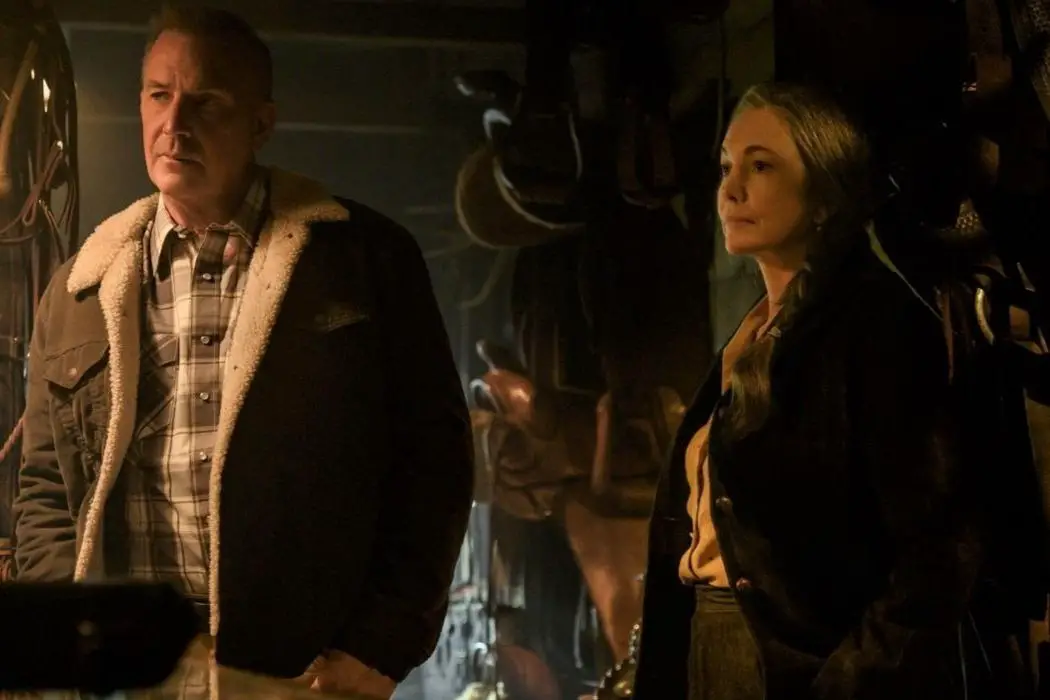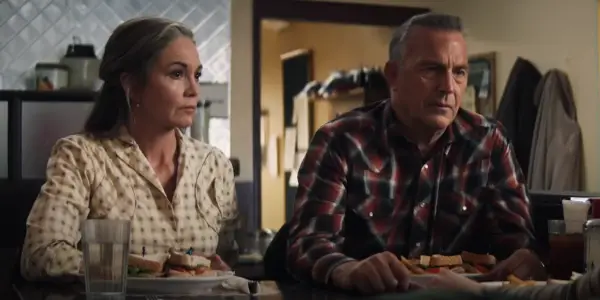LET HIM GO: Slow-Burn Thriller Reuniting Diane Lane and Kevin Costner

Tynan loves nagging all his friends to watch classic movies…
Although Kevin Costner comes from a fairly substantial lineage of modern westerns, it might be the shared context of Costner and Diane Lane from Man of Steel providing the most meaningful background to Let Him Go. Don’t get me wrong. These movies have nothing to do with one another. One was Zack Snyder‘s gargantuan DC blockbuster and this is a slow-burning period thriller from Thomas Bezucha, adapted from Larry Watson‘s 2013 novel.
But I stand by this bit of intuition because so much is gained when romantic costars have a rapport exceeding a single film together. Although we have a few modern examples like Ryan Goslin and Emma Stone or Bradley Cooper and Jennifer Lawrence, there is something lost when we are never allowed this kind of continuity. Because these intangible connections can span genres and subject matter; they get to the heart of the performers themselves, establishing a foundation for the audience to fall back on. If you’re like me, you admire Costner and Lane both; you remember them for earlier roles, even if they are not in the spotlight as much as they used to be. So it is with the passage of time. Still, this surplus of goodwill is hard to forget.
While the western genre is mostly dormant now, every once and a while we see it resurrected, albeit in hybrid forms. What remains powerful is its ability as a vehicle of morality. They are often parables with which to better understand our lives — by going back to the past and digging into themes that pierce the human heart. Because Let Him Go is both a period piece — though set in the 1950s, not the Old West — and also a tale pregnant with grief.
Life’s a List of What We’ve Lost
Let Him Go opens with a generally happy home life. The Blackledges’ grown son works on the ranch. They have a baby grandson. Grandma and Grandpa are contented with the life they have before them. The ’50s aesthetic of the world is drawn out nicely between casual diners, classic cars, horn-rimmed glasses, and Buddy Holly on the radio. However, so quickly life goes awry. Margaret (Lane) realizes a stray horse from the kitchen window. Then, George (Costner) rides out only to find their son dead, apparently from a freak accident after trying to break in the new steed.
It’s a life-changing moment of inconsolable, unimaginable grief. To outlive your own children has to be one of the most crushing experiences for a parent. It’s George, a retired sheriff and a generally subdued husband, who tells his wife, “Sometimes that’s all that life is: a list of what we’ve lost.” It feels like such a small comfort even as it illustrates what they must come to terms with.

The movie itself is made after this tragedy. Their daughter-in-law Lorna (Kayli Carter) takes their grandson Jimmy and gets remarried to a fellow named Donny Weboy (Will Britain). We know so very little about him as they stand before the minister, in the midst of their vows, and Mrs. and Mr. Blackledge are there too, obviously having given their blessing. And yet the union looks to be far from ideal.
After the couple picks up and leaves suddenly, taking the boy with them without any warning, Margaret’s misgivings come pouring out. She’s understandably attached to her son’s boy — she feels responsible for him — and she does not like the implications. Being the independent, obstinate woman that she is, she vows to track them down.
It’s George who provides the voice of reason like always. Even if Lorna agrees to let them bring back Jimmy, what are they supposed to do with him? They’re not exactly young anymore. Still, no matter how much his wife challenges him, he sticks by her. Whatever they do, they always do it together. Most of their exchanges are defined by metered, understated dialogue. It might be indicative of the restraint — some might say repression — of the era. Regardless, it helps generate this slow burn, which remains the film’s best dramatic asset.
The Journey to North Dakota
Their journey continues to the North Dakota badlands. The unease is palpable as if they’re willfully going into the heart of the lion’s den and we can only imagine what it is in store. The breadcrumbs of an abusive marriage become even more fully realized when they finally meet the whole Weboy clan.
The subsequent tension is also painfully strung out – it’s not a Tarantino film, but as characters sit around the dinner table you have the same sense of impending dread supplied by the men sitting around the Hofbrau in Inglorious Basterds. Led by their baleful matriarch (a startlingly memorable Lesley Manville) and flanked by her hulking posse of sons, the casual jokes and veiled threats bubbling under the surface have to amount to something. It’s inevitable.

Without giving away too many of the gory details, the movie certainly ramps up in the second act, delivering on this pervasive sense of dread. They see their grandson, only to be turned away, with Margaret feeling disconsolate. They came all this way for nothing; she’s not willing to allow it to end in this manner.
Conclusion: Let Him Go
There’s a small fear that Let Him Go‘s genre-bending might alienate some of its selected audience. It’s packed with an emphatic pair of performances by actors over 50 and for viewers who have lived long enough to know what grief and hardship are — to raise kids and have grandkids. But it’s a film hardly squeamish about blowing the cover off conventional adult drama.
Kevin Costner becomes some kind of punching bag as an inferno razes a farmhouse, and people get blown to bits. For a film that looked to offer so much nuance in its buildup, it totally loses everything it worked so hard to create thus far. This sounds vaguely like a criticism until I remembered something telling Lane said in an interview with Hollywood Reporter; it’s not about finding a balance but maintaining this imbalance because that’s what life is. Our primal brains are terribly affected by shock and violence, reacting in kind.
One final commendation of the movie is how its title evolves and garners new meaning as the journey progresses. Margaret is our rudder and our guiding force. “Letting him go” is hard for her. What’s most evident is how it’s not a one time process. As the author C.S. Lewis asked in A Grief Observed, “How often — will it be for always? — how often will the vast emptiness astonish me like a complete novelty and make me say, ‘I never realized my loss till this moment?’ The same leg is cut off time after time.”
George mentions he loves his wife because she believes this is the only life we have but horses have souls — opinions at one time dogmatic and somehow spiritual. In the end, she pushes on through this life while making peace with what she has lost. Following the form of the genre, she and her husband help to bring about some form of justice, a renewed sense of restoration to the disordered chaos of the film. And yet even that doesn’t bring “him” back.
How do we stave off that vast emptiness — that same leg being cut off again and again? Maybe it’s a post-war convention to have a stiff upper lip and keep your emotions bottled up. I’m not sure; but if Margaret thinks horses have souls, it seems like, deep down inside, she would like to believe humans do too. If we let them go in this life, could it be possible we will see them in the next? How we answer this question personally says a lot about how we cope with grief.
What other actors would like to see team up again to make use of their chemistry across different genres? Please let us know in the comments below.
Let Him Go was released in theaters in the U.S. on November 6, 2020.
Watch Let Him Go
Does content like this matter to you?
Become a Member and support film journalism. Unlock access to all of Film Inquiry`s great articles. Join a community of like-minded readers who are passionate about cinema - get access to our private members Network, give back to independent filmmakers, and more.
Tynan loves nagging all his friends to watch classic movies with him. Follow his frequent musings at Film Inquiry and on his blog 4 Star Films. Soli Deo Gloria.













